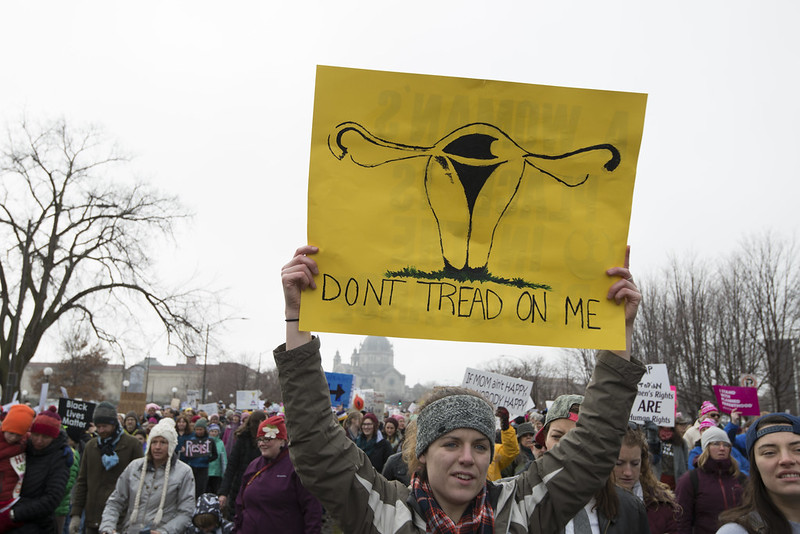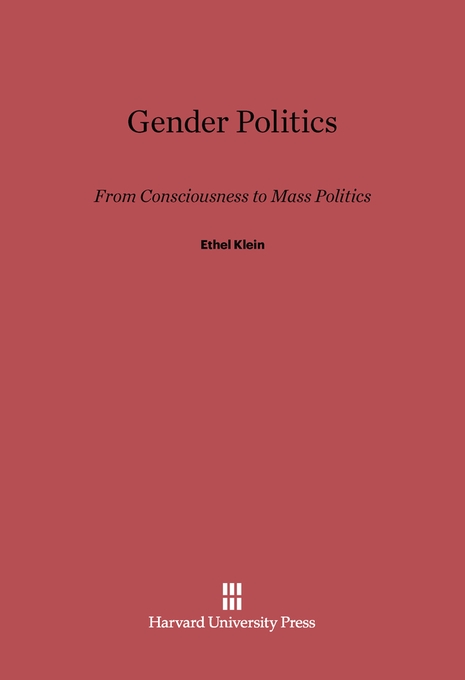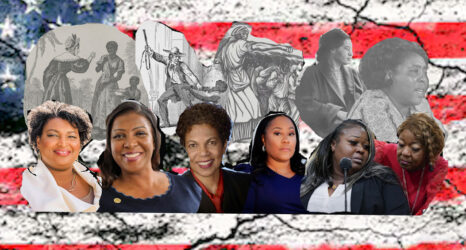As election season gets firmly underway, women’s votes are set to shape the outcome of the 2020 national elections and set the course for the nation’s agenda.
Since the 1980s, a distinct gender gap has shaped the nation’s political and policy agenda, voting patterns and more. It will undoubtedly continue to play a larger and larger role in future elections—including, of course, those in 2020.

Who First Identified the Gender Gap?
The gender gap, first identified by Eleanor Smeal and other ERA activists, emerged in the presidential election of 1980, in which noticeably fewer women than men voted for Ronald Reagan. Although not decisive in that race, by 1982 the gender gap and women’s votes had determined the outcomes of gubernatorial elections in New York, Texas and Michigan, where pro-women’s rights Democrats emerged victorious.
And by 1984, the gender gap was the driving force in the election of Democratic senators in Iowa and Illinois and was decisive in the victories of Democratic senators in Massachusetts and Michigan.
How Does the Gender Gap Affect the Politics of Today?
The gender gap is now a firmly established factor in U.S. elections, driving the outcome of races from local city councils and county boards to Congress and the presidency.
In the 2018 midterm elections, women candidates and women’s votes shifted the balance of power in the U.S. House, and the gender gap was again decisive in the 2019 Kentucky governor’s race, with 56.7 percent of women—but only 44.4 percent of men—voting for the winning pro-women’s rights Democratic candidate.
Early polling suggests the 2020 elections could see record gender gaps. In an Economist/YouGov poll from October, 52 percent of women said they will vote for the Democratic Party’s congressional candidate (only 36 percent said they will vote for the Republican), compared to 43 percent of men who said they will vote Democrat (and 44 percent Republican).
In the same poll, 50 percent of women disapprove of President Donald Trump’s handling of women’s rights issues, with 40 percent strongly disapproving; only 39 percent of men disapprove.
Across all major polls, women—especially women of color, and including politically unaffiliated and independent women—have been more critical of Trump’s actions and more supportive of his impeachment than men. In the most recent Fox News poll available at press time, 54 percent of all women and 69 percent of women of color said they think Trump should be impeached and removed from office, compared to 44 percent of all men.
Ms. Talks the Gender Gap with Harvard Political Scientist Dr. Ethel Klein

To explore what all this might mean, and to better understand the factors driving these large gender gaps, Ms. spoke with Ethel Klein, Ph.D.—leading pollster, gender gap expert and author of the 1984 book Gender Politics: From Consciousness to Mass Politics.
Kathy Spillar: In your book, you describe how it took more than 40 years from the ratification of the 19th Amendment, until the late 1960s, for women’s voter registration and turnout rates to catch up to men’s. Can you explain why?
Ethel Klein: You have to remember that for much of the early history of the U.S., women had no significant legal standing. This was especially true for married women, who were treated according to the concept of coverture, inherited from English common law. A woman was legally considered the chattel of her husband, his possession. Property she might have held before her marriage became her husband’s, and she had no legal right to appear in court, to sign contracts or to do business. Not surprising, women were also prohibited from voting. Voting, like employment, was seen as a man’s role. Challenging this norm took another two generations.
And for African American women, it would take the 1964 Civil Rights Act to legally end the discrimination and segregation that had been institutionalized by Jim Crow laws, and the 1965 Voting Rights Act to end efforts that kept African Americans from voting. Yet despite these important laws, voter suppression efforts—including racial gerrymandering and purges of voter registration rolls aimed at communities of color—remain a problem to this day.
By the late 1960s, though, the gap between men’s and women’s voter registration rates virtually disappeared. Women have constituted a majority of voters in elections since 1964, and by 1980 women’s turnout rate equaled or surpassed men’s.
KS: And that’s when what became known as the “gender gap” emerged—that is, the difference between women and men in their preferences for a particular candidate and their positions on the issues. What were the driving factors behind the emergence of the gender gap?
EK: The gender gap first appeared in the presidential election of 1980, when 54 percent of men voted for Reagan as compared to only 46 per- cent of women, an 8-point gender gap. Reagan won because of men’s votes. By the 1980 elections, the U.S. had come through two decades of massive cultural changes, driven by the changing role of women in society and by powerful social movements: the civil rights movement, the anti-war and environmental movements, the beginnings of the movement for LGBTQ rights, and the movement for women’s rights.
The economic upheavals of the 1970s—including the OPEC oil embargo and quadrupling of energy prices, double-digit inflation, escalating housing and food prices and the loss of manufacturing jobs—meant that traditional two-parent families needed the second incomes that women could provide by entering the paid labor force. At the same time, expectations were changing among women, especially the generation coming of age in the 1960s and ’70s. Women’s participation in higher education was increasing, and by 1979 more women were enrolled in higher education than men. Marriage rates were declining and social norms that in the past had been deeply ingrained in U.S. society were changing.
By 1980, the feminist movement had achieved significant advances for women, including access to birth control and legal abortion with the Supreme Court’s decisions in Griswold v. State of Connecticut and Roe v. Wade, passage of Title IX, the Equal Credit Opportunity Act and the Pregnancy Discrimination Act, among others. And the drive for the Equal Rights Amendment was at its peak, with huge numbers of women everywhere involved and by then acutely aware of the gender inequities baked into our laws, culture and institutions.
An organized backlash to the women’s rights movement had also emerged then. The New Right was on the rise and was heavily focused on pushing back on women’s rights—especially on abortion—further politicizing women’s issues. The Republican Party platform under Reagan promoted a return to more traditional times, coming out against the ERA for the first time and advocating a reversal of Roe.
So by 1980, women’s issues and candidates’ positions were becoming increasingly salient for women voters, and women were finding their political voice. Though not always decisive, the gender gap has persisted, with more women than men voting for Democratic presidential, congressional and gubernatorial candidates, and with women of color, led by African American and Latina women, voting Democratic by even larger margins.
The gender gap has shaped the nation’s political and policy agenda. Driven by support among women voters and their concerns, the Democratic Party and its candidates have increasingly advocated for laws and policies that sup- port women’s rights—from the ERA to equal pay, family and medical leave to ending violence against women.
Moreover, Democrats have been more likely to support human services programs and social policies that comprise the government safety net, and to address the more precarious economic position of women, who earn less than men and still carry disproportionate responsibilities for caregiving, both for children and the aged. These programs, including Medicare and Medicaid, Social Security and the food assistance program SNAP, are of greater concern to women. By contrast, men are less likely to care about or give priority to pre-serving social safety net programs.
KS: In Gender Politics, in 1984, you describe the emergence of a feminist vote—and you predicted that it would grow. The numbers show you were on to something. In the 2012 elections, Ms. identified and defined what we call the “feminist factor,” cutting across all racial and ethnic lines. In the most recent 2018 midterm elections, 77 percent of women voting Democratic identified as feminist compared to 33 percent of women voting Republican. A similar feminist factor was at play among men, with 53 percent of men who voted Democratic identifying as feminists compared to only 23 percent of men voting Republican.
EK: As support among women for the women’s movement has continued to grow, and as feminist issues have become more politicized, it’s no surprise that women increasingly evaluate candidates’ positions on women’s rights. And it’s no surprise that women expect that their concerns should increasingly become a dominant theme in the formulation of public policy.
KS: What should we be watching for in 2020? Will gender continue to be a driving force in voters’ choice of candidates? What would an updated version of Gender Politics highlight today?
EK: There’s no question gender politics and the feminist factor are going to play a major role in the 2020 elections. First, there’s the renewed and widespread activism among women we’ve witnessed since the election of Trump: the massive Women’s Marches, the flood of women running for and winning political office, and all the women who volunteered for their campaigns.
Second, two issues—abortion and sexual violence, what I call “bodily integrity” issues and that I believe are at the heart of the current resurgent demands for women’s equality—are likely going to be key wedge issues in the 2020 elections. The passage of abortion bans in a number of Republican-dominated state legislatures, the attacks by the Trump administration on Planned Parenthood and feder- ally funded family planning programs, and the upcoming Supreme Court case on Louisiana’s abortion clinic restrictions all have made the abortion issue more urgent.
The explosion of #MeToo following the highly publicized Harvey Weinstein sexual abuse allegations; the fight over Brett Kavanaugh’s Supreme Court nomination and the Republican senators’ treatment of Christine Blasey Ford’s allegations of sexual assault; the arrest of Jeffrey Epstein; and the R. Kelly indictments have kept the issues of sexual assault and harassment front and center.
Despite public opinion polling that shows only marginal differences between women and men on these two issues, both are of greater salience to women and to their personal autonomy and self-determination, and thus more likely to drive women’s voting preferences.
KS: And on other issues where we see gender differences in voter attitudes—on equal and fair pay, championed by teachers and by professional women athletes and other cultural icons alike; the epidemic of gun violence and school shootings constantly in the news; health care and the ongoing attacks by the Trump administration on the Affordable Care Act; caging children at our southern bor- der; and the climate crisis—will these be factors in women’s voting decisions?
EK: Yes, to the extent these issues are visible in the elections. But remember, it is the extent to which these issues distinguish candidates from each other that determines the size of gender gap in voting. But I believe, given everything we are seeing now, that 2020 will see the kinds of gender gaps in voting and the surge of women voters— especially among young women voters—that will be decisive in the presidential race, in possibly determining control of the Senate, and in races for governor and state legislatures across the country.





